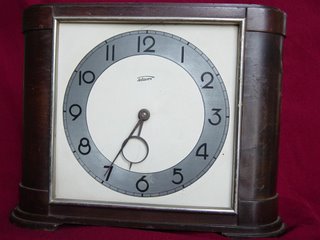Here is my earliest Telavox from the front. The non-striking movement can be seen above in a previous chapter.
The hands are typically Telavox but here the chapter ring is deeply engraved or cast into the solid sheet metal. The Arabic numerals and minute ring graduations are deeply cut.
Later Telavox chapter rings are painted (or more likely printed) and have no depth despite appearances.
Unfortunately, the unusual, square, domed glass is missing from the dial of this clock. My hope is to find another example like this to ensure a replacement glass matches the original.
The case veneer is in rather poor condition. The veneer must have been steamed to wrap round the tight curves of the side of the case. Subsequent dampness, heat or probably dry air from central heating has resulted in some cracking. This is repairable of course. Wood glue could be injected with a syringe through the cracks then the whole bound tightly with rubber bands while the glue dries.
Here is the dial of the large rectangular Telavox previously shown only from the rear. The style of the hands is unique to this clock in my modest collection.
There is some dirt and cobwebs behind the dial. Which could be cleaned up by removal of the dial sheet towards the back of the clock. Photography was very difficult. Trying to get enough light to do the clock justice while avoiding reflections was a bit of a nightmare.
This clock strikes on a small, highly polished bell with a pleasant, clear tone. Slots in the case back are covered with the same type of coarse cloth common to most Telavox clocks. This allows the striking to be heard clearly in the room. In earlier times, when traffic noise levels were much lower than today's hectic world, a striking clock could probably be heard clearly throughout the house.
And now for something completely different. This is an example of a Telavox with a large case that has been painted. These particular colours were once popular for painting furniture of all kinds in Denmark. I have an unpainted example of this case style. I'm not sure I don't prefer the painted version to the large area of original, very dark brown veneer. The painting was certainly very well done. The question remains whether this was a short-lived fashion and when it took place. Changing tastes and changing fashions can be difficult to judge from our own perspective.

And now for something completely different. This is an example of a Telavox with a large case that has been painted. These particular colours were once popular for painting furniture of all kinds in Denmark. I have an unpainted example of this case style. I'm not sure I don't prefer the painted version to the large area of original, very dark brown veneer. The painting was certainly very well done. The question remains whether this was a short-lived fashion and when it took place. Changing tastes and changing fashions can be difficult to judge from our own perspective.
*


No comments:
Post a Comment